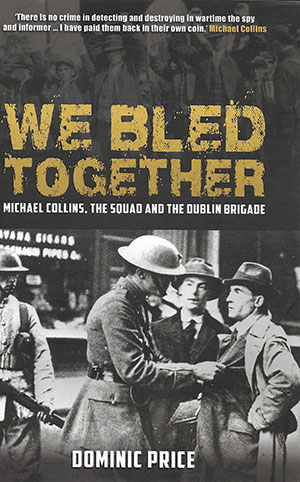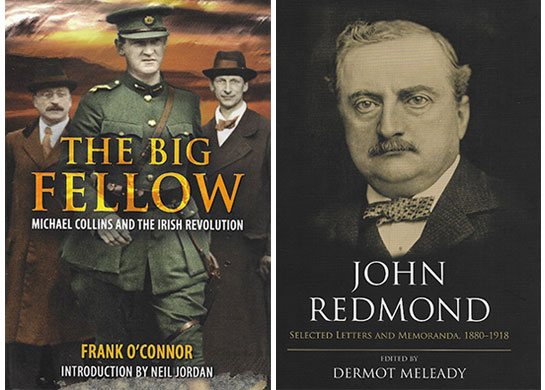BOOKWORM
Published in Book Reviews, Issue 3 (May/June 2018), Reviews, Volume 26By Joe Culley
 In We bled together: Michael Collins, the Squad and the Dublin Brigade, Dominic Price collates much familiar material and, importantly, mines new sources to tell the story of Collins and his ‘Squad’ from before the War of Independence right through to the Civil War and beyond.
In We bled together: Michael Collins, the Squad and the Dublin Brigade, Dominic Price collates much familiar material and, importantly, mines new sources to tell the story of Collins and his ‘Squad’ from before the War of Independence right through to the Civil War and beyond.
This might be called a popular military history. Price is a military man (FCA) and his strength is in the detail of such. We are given maps of the various divisions/battalions of the Volunteers and DMP and their organisational structures, lists of the IRA intelligence officers, and we know the calibre of the weapons and their effective range. We’re given all the relevant street addresses of arms dumps and safe houses, and we can see how the intelligence officers moved about a chaotic city.The actual politics going on which could put some of the violence into context is only cursorily and simplistically addressed, but it’s fair to say that when it comes to the gunplay, such as the comings and goings—assassinations—of Bloody Sunday, Price does hold his audience.
The amount of research supporting the story is to be commended. All the newest available sources are cited, perhaps most importantly the Military Service Pensions Collection. For example, it’s from this that we hear the story of Lily Mernin, who worked as a typist in Dublin Castle and was central to Collins’sintelligence-gathering.
One serious reservation—and this is perhaps a personal thing—concerns the tone of the book. We are in no doubt as to which side we are on. The members of the ‘Squad’ are waging a cruel but necessary war in the fight for Irish freedom. The ‘700 years’of occupation and imperial rule are mentioned more than once. An arms raid is ‘a spectacular success’, a Volunteer gives a ‘resolute’ address at Seán Treacy’s graveside, and many escapes are ‘made good’.
That said, Price does not ignore the human cost levied on both combatants and civilians. Indeed, at the end his tone changes, and he does a fine job of detailing how one of the heroes from the ‘Squad’, Paddy O’Daly, metamorphosed into the architect of the series of atrocities perpetrated by the National Army in Kerry during the Civil War.

And here we might mention that Mercier Press has reissued Frank O’Connor’s 1937 classic,The Big Fellow.
One would imagine that John Redmond would have been content that he had departed the scene just before the ‘Squad’ began its work. Dermot Meleady, the author of a two-part biography of the IPP leader, has now produced John Redmond: selected letters and memoranda, 1880–1918. Remarkably, this is the first such volume published.
This chronological collection focuses almost exclusively on Redmond’s 40-year political life, with letters to and from figures such as Dillon, O’Brien, Lloyd George and Asquith, touching on everything from Parnell’s downfall to the death of Home Rule in 1916 and his own in 1918.Ordinarily these things, as the blurb puts it, ‘gives Redmond back his own voice’. Unfortunately, it seems that Redmond was slow to express emotion in his correspondence, and the letters remain business-like,so it’s not clear whether they offer much insight into the man himself. A brief chapter at the end dealing with personal and family life does, however, include his astonishing reaction to the news that a nephew, who had joined the Benedictines at seventeen, was six years later trying to get out. Redmond effectively disowned the poor lad.Also, I saw nothing on the death of his brother.No doubt Selected letters and memoranda is a must-have for any serious student of the man and his time.
Brian Manners’sThe Trinity College harp is a curious but engaging enterprise. Both the English and Irish versions are in the one publication (just flip the book over), while there are six QR codes embedded which allow you to listen to samples of the music through a smart phone app. (You can also listen at app.trinityharp.ie, which I recommend.) While we learn about the harp—metal strings, curved pillar, large soundbox—we also learn (in a rather folksy way) about all other things Gaelic: societal structure, evolution of the language, rules of hospitality, the ogham alphabet.
Ireland 1916–2016: the promise and challenge of national sovereignty is a collection of essays taken from a 2016 conference in Galway, which was a third-level contribution to that centenary year.Contributors include Philip Pettit, Roy Foster, Kevin Hjortshøj O’Rourke, Clair Wills, Louise Richardson and Brendan O’Leary, who ‘reflect on what the ambitions and achievements of the men and women who supported the Rising … have meant to … Irish people at home and abroad’.Topics include the doctrines of classical republicanism and liberalism; the economic fortunes and failures of the independent state; the cultural representation and interpretation of our post-independence experience; and the role of university education in Ireland.
Another collection of essays to emerge from a conference, this one in 2014, is Historical perspectives on parenthood and childhood in Ireland. It covers the period from 1700 to the 1950s, and topics include the family life of Wolfe Tone, the treatment of mothers sent to the Inebriate Reformatory in Ennis, and the role of dress and gender in childhood.
Liam Kelly’s comprehensive The diocese of Kilmore: c. 1100–1800 ‘gives a fascinating and important insight into the ecclesiastical history of a rural north west of Ireland diocese over a period of seven centuries’.

Dominic Price, We bled together: Michael Collins, the Squad and the Dublin Brigade (Collins Press, €24.99 hb, 392pp, ISBN 9781848893313).
Frank O’Connor, The Big Fellow: Michael Collins and the Irish revolution (Mercier Press, €14.99 pb, 312pp, ISBN 9781781175583).
Dermot Meleady (ed.), John Redmond: selected letters and memoranda, 1880–1918 (Merrion Press, €29.99 hb, 350pp, ISBN 9781785371554).
Brian Manners, The Trinity College harp: Ireland and the most exotic music instrument in the world (Dubhlinn Nua Publishing, €25 pb, 270pp, ISBN 9781527208759).
Tom Boylan, Nicholas Canny & Mary Harris (eds), Ireland 1916–2016: the promise and challenge of national sovereignty; dóchas agus dúshláan na ceannasachta náisiúnta (Open Air, €29.95 hb, 127pp, ISBN 9781846826818).
Mary Hatfield, Jutta Kruse & Ríona Nic Congáil (eds), Historical perspectives on parenthood and childhood in Ireland (Arlen House, €25 pb, 284pp, ISBN 9781851321735).
Liam Kelly, The diocese of Kilmore: c. 1100–1800 (Columba Press, €39.99 hb, 484pp, ISBN 9781782183310).
See more from the author @TheRealCulls
















